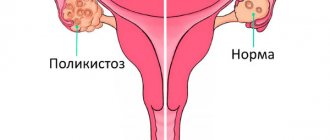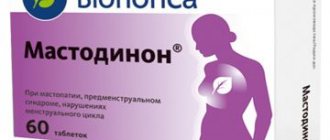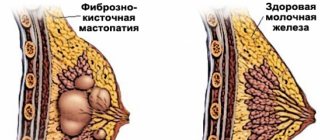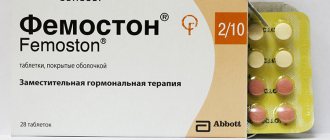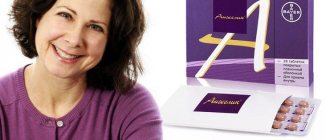The menopausal period is difficult for women, as it indicates the decline of reproductive function, loss of attractiveness, as well as active aging of the body. Early menopause causes the greatest discomfort, since it limits a young woman in many ways. Hormone replacement therapy is used to reduce symptoms. One of these drugs is Femoston for menopause. This medication has many positive reviews, which are due to the high effectiveness of its use, but there are also negative opinions about its use. Before using this drug, you need to familiarize yourself with the principle of its action and composition.
Femoston doctor reviews
All doctors are experts in our service. Doctors' documents have been verified.
Good drug for HRT
Femoston is a well-known and probably the most studied drug for hormone replacement therapy in premenopausal, menopausal and postmenopausal women.
The drug is available in three dosages, the prescribed dose depends on the stage of menopause.
Femoston significantly reduces menopausal symptoms in women, has virtually no effect on libido, effectively resists osteoporosis and reduces the intensity of bleeding (which is the main prevention of iron deficiency).
The drug is well tolerated, but has a number of negative side effects. Therefore, before starting treatment, a woman should carefully read the instructions for the drug and independently decide whether she wants to use Femoston.
Femoston - hormone replacement therapy
Femoston is a combined hormonal drug that is used for hormone replacement therapy. It contains 2 active components: estrogens (estradiol) identical to natural and dydrogesterone - progesterone. Taken together, they provide many positive effects from the use of the drug.
Estradiol has a positive effect on the skin, slows down its aging, smoothness, also eliminates vaginal dryness and makes intimate life possible, painless and comfortable. Prevents atherosclerosis and osteoporosis, hot flashes, sweating, sleep disturbances, dizziness, headaches, atrophic changes in the skin and mucous membranes.
Dydrogesterone is the progesterone component of the drug and does not have any adverse effects. It is necessary to reduce the growth of the endometrium while taking estrogen and to protect against endometrial hyperplasia and endometrial cancer.
This drug has shown good results in the treatment of menopausal disorders in premenopausal, menopausal and postmenopausal women. It is also widely used in women with castration syndrome (during removal of the ovaries). This way it significantly improves their quality of life and eliminates the symptoms of menopause.
Femoston is available in tablet form, in three forms - 1/10, 2/10 and 1/5, which differ in the composition of hormones in the drug. They are taken one tablet at the same time every day, regardless of meals. The drug is taken for a long time without breaks. Women who have not yet finished menstruation should take Femoston 1/10 or 1/20 from the first day of menstruation; those who do not have menstruation and have a longer menopause should take 1/5.
Femoston is a high-quality, original drug for hormone replacement therapy. It has a positive effect on the woman’s body as a whole, reducing the symptoms of menopause and thereby improving its quality and duration.
Release forms
This drug is produced in the form of tablets containing various dosages, which are selected according to the individual characteristics of each woman. These tablets may have the following dosage:
- 1/5 Conti;
- 1/10 Conti;
- 2/10 Conti.
Where the values 1 and 2 in the numerator are indicators of the amount of estradiol in one tablet, expressed in milligrams. Accordingly, the values 5 and 10 in the denominator indicate the level of dydrogexterone content.
Additional substances contained in this medication include:
- colloidal silicon dioxides;
- corn starch;
- magnesium stearates;
- lactose monohydrate and other excipients.
The tableted drug Femoston is available in 28 tablets in one blister, on which the days of administration are marked.
One package of the drug is designed for a two-week course.
When is it prescribed?
The indication for the use of this drug is estrogen deficiency in women during menopause. Use no earlier than 6 months after the last menstruation. Menopausal manifestations may be individual for each patient, but general symptoms are still present. These are hot flashes, irritability, mood swings, dry skin and mucous membranes (including the vagina), pain during sexual intercourse, and unstable blood pressure.
Another indication is the prevention of osteoporosis in postmenopausal women. In this situation, the drug is prescribed even in the absence of clinical manifestations of menopause, if there are contraindications for the use of specialized drugs for the treatment of osteoporosis.
Composition and mechanism of action
In accordance with the labeling, the active components in three types of Femoston are estradiol and dydrogesterone.
Auxiliary components are:
- lactose monohydrate;
- corn starch);
- colloidal silicon dioxide;
- hypromellose;
- Magnesium stearate.
NOTE!
The functions of estradiol in Femoston are similar to organic estrogen, which is produced by the ovaries in the female body.
The mechanism of its action is to compensate for the lack of estrogen during the postmenopausal period due to a decrease in the secretory activity of the ovaries.
This happens:
- normalization of psycho-emotional symptoms;
- elimination of hot flashes;
- inhibition of the process of atrophy of the genitourinary system;
- improving vascular elasticity and skin condition.
Dydrogesterone (progesterone) helps maintain a stable mucous layer of the endometrium, which prevents its growth and prevents the formation of destructive processes in bone tissue.
Femoston provides low-dose hormone replacement therapy.
How to use
The package contains 28 tablets. All of them contain estrogen for continuous use. Progesterone is also added to the second 14 tablets. Therapy begins with taking pink tablets, and then switches to yellow tablets. The drug is used without interruption: after finishing the package, the next one immediately begins.
Medicines for menopause: Femoston 210, 110, 15 conti - are prescribed in different situations. The dosage of 15 conti is used in women with long-term menopause, when there are no longer pronounced menopausal symptoms, but the drug is needed to prevent bone fractures associated with the development of osteoporosis, to stabilize the course of hypertension, when taking antihypertensive drugs alone does not give the desired effect. In this situation, when prescribing the drug "Femoston", doctors' reviews about it are only positive. This is especially true for cardiologists who are not afraid to recommend hormone replacement therapy to their patients. The result is a stable reduction in blood pressure and a reduced risk of acute myocardial infarction.
The instructions for the drug state that the experience of use in women over 65 years of age is limited, but this does not mean that it is impossible. The main thing is to correctly weigh the pros and cons.
Distinctive features of the hormonal drug Femoston
The drug in question is a type of hormonal antimenopausal drugs of a two-phase type. It is based on two artificially synthesized hormones that are designed to compensate for the lack of female sex hormones: estradiol and dydrogesterone. The second hormone is a substitute for progesterone. It prevents the formation of hormone-dependent tumors.
Estradiol also helps to cope with the lack of estrogen, which is the main culprit in the unbalanced state of the nervous system during menopause. If you continue taking Femoston after menopause, it will prevent the manifestations of osteoporosis. This will significantly reduce the risk of fractures.
In their complex interaction, these two hormones effectively help fight the symptoms of menopause, significantly reducing the severity of its negative manifestations. In addition, the positive effects of taking this drug are that it stabilizes metabolism and reduces cholesterol levels in the blood. Patients taking Femoston note that its use contributes to a noticeable improvement in the condition of the skin and hair and significantly prolongs youth.
Alternative uses
The drug "Femoston" 2/10, reviews of which can be found on most women's websites, is currently also used in patients of reproductive age. The question arises: “Why?” After all, this indication is not stated in the instructions. Nevertheless, reproductive specialists have found that due to the fact that the composition of the drug is identical to natural female hormones, it helps to cope well with such a problem as thin endometrium. These are situations when the lining of the uterine cavity does not correspond to the day of the menstrual cycle, which leads to the impossibility of developing pregnancy even if the egg is fertilized.
But what does practice show, does pregnancy occur with Femoston 2/10? Reviews on forums are most often negative. Patients complain that the menstrual cycle is disrupted, the discharge itself becomes profuse, but there is still no ovulation, and for some, the endometrium still does not grow. But there are also isolated positive reviews. This suggests that the drug in combination with the addition of duphaston in the second phase of the cycle has a positive effect, pregnancy occurs, only the course of treatment should not be 2-3 months, but at least six months. Therefore, the drug “Femoston” is 2/10, reviews of which can be found are diametrically opposed.
The drug "Femoston" 1/10, reviews for which are also easy to find, has more positive recommendations. Some doctors are trying to prescribe it to patients of reproductive age in order to regulate the menstrual cycle. But here, as a rule, it does not work - insufficient levels of hormones. And when prescribed to women of menopausal age, it works well. "Femoston" 1/10 patient reviews are mostly positive. It is well tolerated and causes virtually no side effects.
To summarize, we can say that the drug "Femoston", doctors' reviews confirm this, is the safest and most effective in treating the manifestations of menopausal syndrome, normalizing the menstrual cycle and preparing for pregnancy in women with endometrial pathology.
This medicine is not used for children and adolescents.
What is this product used for?
The external manifestations of menopause are caused by hormonal changes in the body.
The main reason for these changes is the suppression of ovarian function , which gradually ceases to produce estrogen - the female sex hormone of beauty, youth, and the ability to conceive. Against the background of a decrease in estrogen, the entire hormonal background is destabilized.
The drug Femoston 2/10 is a hormonal drug that compensates for estrogen deficiency and can also treat pathological uterine bleeding.
The drug stabilizes hormonal levels - the deficiency of organic estrogen is replaced by synthetic estrogen, due to which the hormonal balance is normalized.
The ability of Femoston 2/10 to normalize the balance of hormones has a positive effect on the body:
- restores the psycho-emotional state of a woman;
- eliminates the severity of hot flashes;
- relieves dizziness, eliminates headaches;
- improves sleep;
- improves skin condition (eliminates flaking, dryness);
- eliminates increased sweating.
In addition, estrogen is capable of:
- increase the elasticity of the genitourinary system and blood vessels;
- normalize heart rate;
- prevent the development of osteoporosis;
- ensure bone strength.
Due to the presence of dydrogesterone (an active analogue of progesterone) in the drug, the condition of the uterine mucosa is normalized, eliminating the risk of hyperplasia.
About other drugs for menopause symptoms
Negative manifestations
Like any medicine, this drug may have side effects. Their severity determines whether the patient will continue to use the drug in the future. Such manifestations include:
- headaches, may be migraine-like pain;
- dyspeptic symptoms;
- abdominal pain;
- bloating;
- leg cramps;
- soreness of the mammary glands;
- menstrual irregularities, which can manifest as heavy discharge, pain, spotting in the middle of the cycle;
- weight fluctuations (some people note a decrease in weight, while others, on the contrary, an increase in body weight).
Among the rare manifestations, it is worth noting: the development of candidiasis, the growth of myomatous nodes, decreased libido, mood swings, syncope, the development of thrombosis, the formation of gallstones, allergic manifestations to the components of the drug, edema, which can cause weight gain.
When the drug should not be used
This medicine should not be used if:
- hypersensitivity to any component of the drug;
- breast cancer in the past or present;
- the presence of hormone-dependent formations;
- bloody discharge from the genital tract for an unknown reason;
- endometrial hyperplasia in the absence of a histological conclusion;
- thrombosis in the past or present;
- thrombophilia;
- IHD, acute myocardial infarction, ischemic stroke;
- exacerbation of liver diseases;
- porphyria;
- pregnancy and lactation;
- patients under 18 years of age.
In gynecological practice, the drug "Femoston" is often prescribed for menopause. Reviews from doctors make it possible to track the frequency of occurrence of certain side effects and help find ways to combat them.
Femoston® mini (Femoston® mini)
The drug is prescribed only in the presence of symptoms that adversely affect the quality of life. Therapy should be continued until the benefits of taking the drug outweigh the risk of adverse reactions.
Experience with the drug in women over 65 years of age is limited.
Information about the risks associated with HRT in cases of premature menopause is limited. Due to the lower absolute risk in younger women, their benefit-risk ratio may be more favorable than in older women.
Medical examination
Before prescribing or resuming therapy with Femoston® mini, it is necessary to collect a complete medical and family history and conduct a general and gynecological examination (including the mammary glands) of the patient in order to identify possible contraindications and conditions requiring precautions. During treatment with Femoston® mini, it is recommended to conduct periodic examinations, the frequency and nature of which are determined individually, but not less than once every 6 months. It is advisable to conduct instrumental research methods (for example, mammography) for additional examination of the mammary glands. Women should be informed about possible changes in the mammary glands, which should be reported to their doctor.
The use of estrogens may affect the results of the following laboratory tests: determination of glucose tolerance, study of thyroid and liver functions.
Hyperplasia and endometrial cancer
In women with a preserved uterus, the risk of developing endometrial hyperplasia and cancer increases with long-term estrogen monotherapy. The risk of developing endometrial cancer when patients use estrogen only depends on the dose and duration of treatment and increases from 2 to 12 times compared to patients not receiving therapy; the risk may remain elevated for 10 years after stopping therapy.
In women with a preserved uterus, the use of HRT drugs containing only estrogen is not recommended due to the increased risk of developing endometrial cancer. Cyclic use of progestogen (at least 12 days of a 28-day cycle), or continuous use of combined HRT drugs in women with a preserved uterus, may prevent the risk of endometrial hyperplasia and cancer increased by estrogen.
For the purpose of timely diagnosis, it is advisable to conduct ultrasound screening and, if necessary, conduct a histological (cytological) examination.
Bloody vaginal discharge
In the first months of treatment with the drug, there may be bleeding and/or scanty spotting from the vagina. If such bleeding appears some time after the start of therapy or continues after cessation of treatment, its cause should be determined. An endometrial biopsy may be performed to rule out malignancy.
Venous thromboembolism
HRT is associated with a 1.3-3-fold risk of developing venous thromboembolism (VTE), i.e. deep vein thrombosis or pulmonary embolism. This phenomenon is most likely during the first year of HRT.
If there is a family history of thrombosis/thromboembolism in first-degree relatives aged less than 50 years, as well as a history of recurrent miscarriage, it is necessary to conduct a hemostasis study (screening reveals only some of the disorders of the blood coagulation system).
If the patient is taking anticoagulants, a careful assessment of the benefit-risk ratio should be carried out when using Femoston® mini. Until a thorough assessment of the factors for the possible development of thromboembolism or the initiation of anticoagulant therapy is completed, Femoston® mini is not prescribed.
If a thrombophilic condition is detected in a family member and/or in the case of the seriousness or severity of the defect (for example, antithrombin III deficiency, protein S or C deficiency, as well as a combination of defects), Femoston® mini is contraindicated.
Since patients with diagnosed thrombophilic conditions have an increased risk of developing venous thromboembolism, the use of Femoston® mini, which increases this risk, is contraindicated.
In most cases, risk factors for developing VTE include: estrogen use, older age, major surgery, prolonged immobilization, obesity (body mass index > 30 kg/m2), pregnancy or the postpartum period, systemic lupus erythematosus and cancer. There is no consensus on the possible role of varicose veins in the development of VTE.
To prevent VTE after surgery, prophylactic measures should be considered in all postoperative patients.
To prevent VTE in case of prolonged immobilization after surgery, major surgery, surgery on the lower extremities, pelvic area or neurosurgical operation, major trauma, the drug is stopped and resumed only after the woman has restored full mobility. In case of planned surgery, the drug should be stopped 4-6 weeks before surgery.
If VTE develops after initiation of therapy, the drug should be discontinued and patients should be informed that they should contact their physician immediately if any possible symptoms of thrombosis/thromboembolism occur (eg, tenderness or swelling of the lower extremities, sudden pain in the chest, shortness of breath).
Mammary cancer
Current evidence suggests an increased risk of developing breast cancer in women taking HRT with combined (estrogen + progestogen) drugs and also, possibly, only estrogens. The risk depends on the duration of HRT use.
HRT with combined (estrogen + progestogen) drugs
A randomized placebo-controlled trial (the Women's Health Initiative (WHI) study) and epidemiological studies have shown an increased risk of breast cancer in women taking combined (estrogen + progestogen) HRT. The increase is noticeable after approximately three years of therapy.
Estrogen therapy
In the WHI study, there was no increased risk of breast cancer in women with a previous hysterectomy who received estrogen-only HRT. The results of observational studies, for the most part, showed a slight increase in the risk of being diagnosed with breast cancer, while this risk was noticeably lower than in women taking combined HRT (estrogen + progestogen) drugs.
The increase in risk becomes noticeable after several years of use of HRT drugs, but after stopping therapy it returns to the original level within a few (maximum five) years.
Against the background of HRT, especially HRT with combined (estrogen + progestogen) drugs, there is an increase in the density of breast tissue during mammography, which can complicate the diagnosis of breast cancer.
Ovarian cancer
Ovarian cancer is much less common than breast cancer. Epidemiological data obtained from a large meta-analysis indicate a small increase in the risk of developing ovarian cancer in women receiving HRT, both combination drugs and drugs containing estrogen alone. According to studies, the risk of developing ovarian cancer increases with a duration of therapy of more than 5 years, and after its cessation it gradually decreases.
Findings from a number of other studies, including the WHI, indicate that combined HRT is associated with a similar or slightly lower risk of ovarian cancer.
Risk of ischemic stroke
Combination therapy with estrogen and progestogen or therapy with estrogen alone is associated with a 1.5-fold increase in the relative risk of ischemic stroke. The risk of hemorrhagic stroke does not increase when using HRT drugs. The relative risk is not affected by age or timing of menopause, but the baseline risk is highly dependent on age, so the overall risk of stroke in women taking HRT will increase with age.
Coronary heart disease (CHD)
In randomized controlled clinical trials, there was no evidence of a protective effect of HRT against myocardial infarction in women with or without coronary artery disease who received HRT with combined (estrogen + progestogen) drugs or estrogen alone.
HRT with combined (estrogen + progestogen) drugs
The relative risk of coronary heart disease during the use of HRT with combined (estrogen + progestagen) drugs increases slightly. Because the absolute risk of CAD is highly age dependent, the number of additional cases of CAD due to combined estrogen + progestogen HRT use in healthy premenopausal women is very small, but increases with age.
The risk is slightly higher in women over 60 years of age.
Other states
Estrogens can cause fluid retention, which may adversely affect patients with impaired renal or cardiac function. This group of patients should be under medical supervision.
In women with hypertriglyceridemia, while taking drugs for HRT, in very rare cases, the concentration of triglycerides in the blood plasma can significantly increase, which contributes to the development of pancreatitis.
Estrogens increase the concentration of thyroxine-binding globulin, which leads to an overall increase in the concentration of circulating thyroid hormones, as measured by determination of plasma protein-bound iodine, thyroxine (T4) concentration - chromatographic or radioimmunoassay, or triiodothyronine (T3) - radioimmunoassay. A labeled triiodothyronine uptake test shows elevated levels of thyroxine-binding globulin. Free T4 and T3 levels remain unchanged. Plasma concentrations of other binding proteins (eg, transcortin, sex hormone binding globulin) may also be increased, resulting in increased concentrations of circulating corticosteroids and sex hormones.
The concentrations of free or biologically active hormones do not change. It is possible to increase the concentration of other plasma proteins (renin-angiotensin system, α-1-antitrypsin, ceruloplasmin).
The use of HRT does not improve cognitive function. There are reports of an increased risk of developing dementia in women who start using HRT (combined or estrogen-containing only) after 65 years.
Femoston® mini is not a contraceptive.
Results
When using the drug "Femoston" for menopause, doctors' reviews state that the patient receives an improvement in well-being due to the cessation or significant reduction of menopausal symptoms, prevention of the development of osteoporosis (and with it the prevention of bone fractures), and protection from the progression of cardiovascular pathology.
Every woman at any age wants to look healthy and attractive. Hormone replacement therapy helps make this wish come true. Should I use Femoston during menopause? Reviews from doctors say yes.
How to take Femoston during menopause, reviews from women
The menopausal period is difficult for women, as it indicates the decline of reproductive function, loss of attractiveness, as well as active aging of the body. Early menopause causes the greatest discomfort, since it limits a young woman in many ways. Hormone replacement therapy is used to reduce symptoms. One of these drugs is Femoston for menopause. This medication has many positive reviews, which are due to the high effectiveness of its use, but there are also negative opinions about its use. Before using this drug, you need to familiarize yourself with the principle of its action and composition.
Effect of the drug
Femoston is considered a modern hormonal drug, the positive effect of which is due to its composition. The first component is estradiol, the composition of which is very similar to the natural hormone produced by women's ovaries. This substance increases the level of estrogen in the body, thereby eliminating menopausal symptoms - headaches, hot flashes, insomnia, excessive sweating. The skin becomes smooth and elastic, hair stops falling out, and your mood improves. Positive changes affect the reproductive system: the drug eliminates discomfort in the vagina by producing natural lubrication. Thus, the woman resumes sexual relations with her partner.
Dydrogesterone is also very necessary for women, since it ensures the growth of the mucous layer of the uterus and acts as a preventive measure against tumor formation. The action of this component is aimed at reducing the likelihood of developing severe consequences caused by taking estradiol.
Indications and contraindications
The drug is prescribed in the following cases:
- The impact of hormone replacement therapy during menopause, during which a woman suffers from intense hot flashes, rapid heartbeat, frequent dizziness and psycho-emotional disorders.
- Quite often, menopause causes weakness of bone tissue. In this case, Femoston is used to increase the level of minerals and calcium in the bones.
Taking the medication is strictly contraindicated in the following situations:
- Improper blood circulation in the brain - the cause of this pathology is heart attack and stroke, cancer, porphyria.
- Proliferation of endometrial tissue.
- Pregnancy and lactation period.
- Suspicion of the development of endometrial cancer.
- Unreasonable heavy bleeding.
- The presence of excessive sensitivity to the composition of Femoston.
- Development of acute pathological processes in the liver.
- High probability of vascular blockage.
The drug should not be taken by patients under the age of majority. There are relative contraindications for use:
- Presence of diabetes mellitus.
- Family predisposition to cancer.
- Presence of epileptic seizures.
- Presence of bronchial asthma.
- Improper functioning of the kidneys.
- Unstable blood pressure, which is characterized by sudden changes.
- Frequent headaches and migraine attacks.
Contraindications
Since a steroid can affect the entire endocrine system, some chronic diseases may worsen. Contraindications for the use of Femoston are:
- The presence of breast tumors of various etiologies, which can actively grow while taking hormones.
- Vascular thrombosis, which is fraught with the development of stroke and vascular infarction.
- Acute and chronic liver diseases, including cholecystitis. If it is necessary to use hormone therapy in combination, hepatoprotectors are prescribed.
- Renal failure, which affects the half-life of the drug from the body, increasing the concentration of the hormone in the blood several times the normal level.
- Pathologies of the cardiovascular system: tachycardia, arrhythmia, acute heart failure, angina pectoris, ischemia.
- Diabetes mellitus and pre-diabetic conditions, which can be aggravated by hormones.
If a woman suffers from mental disorders and is inadequate, the use of tablets should be done under the supervision of a responsible person. It is strictly forbidden to leave the packaging of the medicine in an accessible place, which can provoke an overdose and the development of a life-threatening condition.
It is not recommended to use this product without medical justification. Only the results of clinical studies showing estrogen deficiency are a reason to start taking Femoston. Irregularity of menstruation can have a number of other reasons not related to menopause (including a tumor process).
Instructions for use
Femoston for early menopause is produced in three types, each of which has its own scheme of use.
- Femoston 1/5 is taken daily, one pill at a certain time of day. Women who have taken another hormonal drug can use Femoston, provided they have completed the previous course of medication. If the drug provides a combined regimen, you can not wait for the end of therapy, but supplement it with Femoston. If you miss a scheduled medication dose, the tablet can be taken within the next twelve hours. If the prescribed time has passed, you must skip taking the drug. It is important to take the pills on time to avoid causing severe bleeding.
- Femoston 1/10 involves taking one pill daily. The treatment course lasts 28 days: for the first fourteen days the woman uses white tablets, the next two weeks - gray tablets.
- Femoston 2/10 should be taken every day, one pill. Drug therapy lasts for 28 days. The first two weeks the woman takes pink tablets, the next two weeks - yellow tablets. If a woman has menstruation during menopause, it is recommended to start taking the medicine on the first critical day. In case of an unstable menstrual cycle, treatment with the drug can be carried out only after two weeks of progestane therapy. If menstruation has been absent for more than one year, treatment can be started immediately.
Contraindications to treatment with Femoston 2/10
Before starting treatment with Femoston 2/10, you should be sure to read the instructions that can be found in the package.
It is worth paying attention to contraindications and, if you have them, refuse therapy. Such contraindications include the following:
- Allergic reactions or other individual intolerance to one of the components of the drug;
- Pregnant women and mothers who are breastfeeding should not take this medicine;
- Malignant pathology of the mammary glands or if there is a suspicion that there is one;
- Hormone-dependent tumors or suspicion of their presence;
- A woman's tendency to bleed from the uterus;
- Endometrial hyperplasia;
- Various liver pathologies;
- Various kidney pathologies. It is especially prohibited to take the drug if there is a history of renal failure;
- Adrenal dysfunction;
- Thromboembolism of veins or arteries.
In the presence of pathologies of the heart and blood vessels, as well as in women suffering from diabetes, this medicine should be taken with extreme caution. In some cases, taking this drug causes a number of quite unpleasant and serious side symptoms. It includes the following signs:
- The appearance of blood from the genitals;
- Pain in the chest;
- Cervical erosion;
- Negative changes in the functioning of the digestive system;
- Head pain and dizziness;
- Chorea.
If you notice such symptoms, you should not delay your visit to the doctor. Most likely, the treatment will have to be adjusted. The doctor may choose a different course of treatment, in particular non-hormonal medications.
Side effects
A significant disadvantage of the drug is the presence of unpleasant side effects:
- pain and feeling of heaviness in the chest;
- heavy blood loss;
- severe pain in the lower abdomen;
- a depressive state, which is aggravated by apathy and indifference;
- headaches and migraines;
- formation of a rash on the skin;
- discomfort, severe itching in the vagina;
- formation of peripheral edema;
- high risk of heart attack;
- development of vaginal candidiasis;
- attacks of nausea and vomiting.
Symptoms of menopause
In addition to dizzying and tiring hot flashes, in which the body temperature rises and heavy sweating occurs, as well as possible darkening of the eyes and temporary loss of orientation, other symptoms may occur during menopause:
- disturbance of the stability of the menstrual cycle;
- frequent attacks of tachycardia;
- unreasonable increase in body weight;
- insomnia;
- irritability;
- increased fatigue;
- frequent headache.
IMPORTANT!
In some cases, the symptoms of menopause make a woman quite tired. Hot flashes, especially at night, interfere with proper rest; headaches and increased sweating literally interfere with normal functioning.
To suppress the symptoms of menopause and return a woman to normal life, doctors prescribe medications that can stabilize the condition and normalize the functioning of all body systems. One such remedy is Femoston 2/10.

